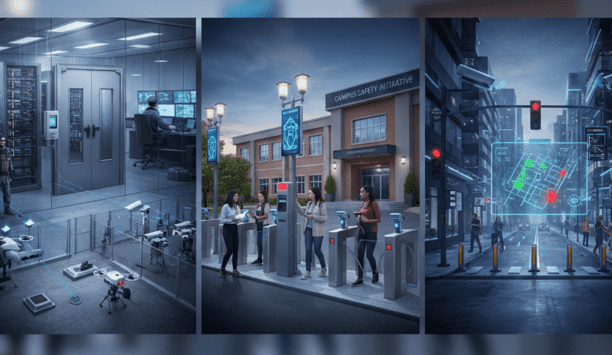My first impression on visiting HID Global’s headquarters in Austin, Texas, was a profusion of light. Plenty of Texas sunshine beams through the abundant windows to provide brightness throughout the building.
Mike Klein, HID Global’s manager of corporate communications and global public relations, led a tour of the headquarters facility on my recent trip to Austin. Including 250,000 square feet of manufacturing space, the building consolidates several previous North American manufacturing facilities into one location. The building’s modern design – including all those windows – also provides space for the company’s distribution and operations such as marketing, finance, IT, and customer service.
Plenty of natural light
"One of the features is the natural light, which has statistically been shown to be more productive to employees, and from a cost perspective, we don’t have to light the interior of the building as much" |
“From the ground up, we had the advantage of doing something a bit more sustainable in the design-build,” says Klein. “One of the features is the natural light, which has statistically been shown to be more productive to employees, and from a cost perspective, we don’t have to light the interior of the building as much. So you will see a lot of administrative operations are located on the perimeter to enjoy the natural light.”
LEED Platinum rating
Copious natural light is just one aspect of the building’s environmentalism, which has earned it the LEED Platinum rating from the U.S. Green Building Council. (LEED stands for Leadership in Energy and Environmental Design.) It is the only industrial manufacturing facility in Texas to achieve the highest, platinum-level distinction. Use of natural lighting increases productivity while lowering energy needs by a third. Efficient LED bulbs are used throughout the facility. The building also received four stars (out of five) from the Austin Energy Green Building program, which focuses on the Texas city’s more stringent energy, water and indoor environmental quality requirements.
Asphalt parking lot
The two-toned asphalt in the parking lot is evidence that 16,000 cubic yards of asphalt from the old Austin Executive Airport runway and hangar (located at the same site) were repurposed into the new parking lot. Some 190,210 pounds of metal and 98,320 pounds of concrete were also recycled. Faucets and bathroom fixtures use less water, and half of building runoff water is collected and drained into a natural retention pond nearby – less erosion and impact on groundwater.
HID brought a large number of new jobs to Austin, including employment of unskilled labour that is trained for specialised manufacturing |
Two electronic vehicle (EV) charging stations and 20 bicycle storage racks in the parking lot also attest to a commitment to environmental goals. (Virtual ID controls access to the EV charging stations – and to vending machines.) The building is also within walking distance of public bus lines, a carpool station and a commuter rail stop. Employee amenities include walking paths and other general conveniences, and family neighbourhoods are only half a mile away.
Increased employment
Since relocating to Austin from California in January 2014, HID Global has hired more than 300 employees and completed consolidation of North American manufacturing operations – 45 percent of all global revenue is now generated out of the new facility. Austin’s central location – and almost $100 million in tax breaks –influenced selection of the site. HID brought a large number of new jobs to Austin, including employment of unskilled labour that is trained for specialised manufacturing. Fewer than 30 people relocated from California.
Commitment to sustainability
This month, HID Global will receive ISO 9001 (environmental impact) certification for its Austin facility, which produces 7 million cards each month. HID Global already holds the ISO 9001 certification for its Malaysian and Galway, Ireland, facilities.
The security market has been slow to embrace the value of environmentalism, but HID’s green building also reflects its wider commitment to sustainability |
The security market has been slow to embrace the value of environmentalism, but HID’s green building also reflects its wider commitment to sustainability. As part of ASSA ABLOY, HID is conscious of the building trade’s increasing preference for green products, including use of Environmental Product Declarations, which are statements resembling nutrition labels that designate compliance with green objectives. Although the energy used by card readers is a fraction of a building’s costs, Assa ABLOY sees a demand for greener components related to all aspects of a door opening. HID’s corporate offices use more than 3,000 Assa Abloy products, including a climate-controlled mantrap that helps to keep energy costs low.
From plastic cards to the cloud
And HID is leading the move away from plastic cards and toward virtual credentials stored in the cloud (which offers obvious green advantages). Getting away from cards would be especially beneficial to the hospitality industry, which creates plastic cards that are used only briefly. HID recently worked with Starwood Hotels and Resorts Worldwide to supply a keyless entry system allowing Starwood Preferred Guest members to use their smartphone or Apple Watch as a key (incorporating HID’s Seos Mobile ID platform).
HID’s Seos credential is now available for the same price as a proximity card, and can be used with various legacy technologies, multi-technology readers and even in lieu of passwords for cloud-based authentication.
HID’s Trusted Tag Services provides cloud-based authentication that can be used in marketing applications – using a NFC tag embedded in a movie poster that can be scanned by a smart phone, for example (and used instead of a bar code or QR code). The system can also be useful in healthcare as electronic visitor verification, for example to confirm that a visiting nurse was on site with a patient.
In addition, the Austin facility houses much of HID’s high-security government business, which includes 50 different government programs including the U.S. Green Card. An optical media strip on cards stores data and can be personalised, but cannot be counterfeited. (The strip is also now available to be applied to cards by end users, providing some of the high-security functionality).
Learn why leading casinos are upgrading to smarter, faster, and more compliant systems















































